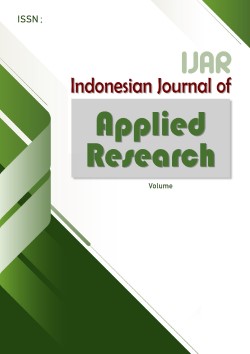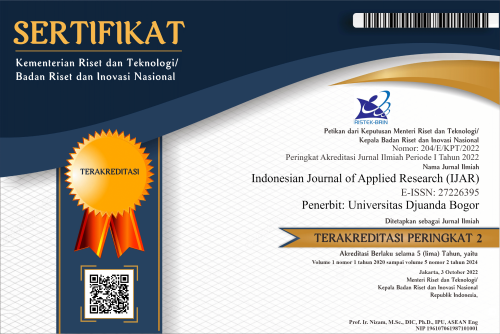Isolation and Identification of Lactic Acid Bacteria (LAB) Producing Bacteriosin-Like from Smoked Giant Catfish (Arius Thalassinus)
Abstract
Bacteriocin was bacterial metabolite that have antimicrobial properties, so it had the potential to be used as food bio preservatives. Bacteriocin was produced by lactic acid bacteria (LAB), one of the sources of which was from smoked fish products. Some regions in Indonesia produce various types of smoked fish from various types of fish, which were thought to contain bacteriocin-producing lactic acid; one of them was giant cathfish (Arius thalassinus). This study aims to obtain LAB isolates that have strong antimicrobial activity and have the potential to produce bacteriocin-like from smoked giant catfish (Arius thalassinus). The research method used an experimental method that analyzed descriptively. Based on the results, there were 15 isolates LAB isolated from smoked giant catfish. Three selected isolates showed strong antimicrobial activity inhibiting E. coli and S. aureus bacteria, and the most effective inhibiting Salmonella sp. One selected LAB isolates identified Pediococcus acidilactici suspected to produce pediocin bacteriocin-like, while the other two isolates identified Lactobacillus plantarum sp 1 and Lactobacillus plantarum sp 2 which suspected to produce plantaricin bacteriocin. Bacteriocin from the three isolates of LAB had characteristics stable to temperatures up to 121oC, stable in pH range 2-6, and bacteriocin activity increased with the addition of SDS (Sodium Dodecyl Sulfate) and EDTA (Ethylenediaminetetraacetic acid) surfactants. The conclusion was that the bacteriocin produced was stable at high temperature, low pH, and resistence in the presence of surfactants, so it had the potential to be developed as biopreservatives material in preserving fish-based foods
References
Anriana, Y. (2015). Aplikasi Bakteri Asam Laktat Pediococcus acidilactici Asal Whey Dangke pada Pengawetan Bakso.
Bappenas. (2014). Study of Sustainable Fisheries Management Strategies. Ministry of PPN
Burhanuddin, S., Djamali, A., Martosewojo, S., & Hutomo, M. (1987). Sumber daya ikan manyung di Indonesia. LON-LIPI. Jakarta.
Gálvez, A., Abriouel, H., BENOMAR, N., & LUCAS, R. (2010). Microbial antagonists to food-borne pathogens and biocontrol. Microbiologie. Université de Jaén, 23071 Jaén. Espagne. GALVAREZ A., ABRIOUEL H., LOPEZ RL and OMAR NB (2007) Bacteriocin-Based Strategies for Food Bioservation. International Journal of Food Microbiologye, 120(1–2), 51–70.
Hidayati, L., Chisbiyah, L., & Kiranawati, T. (2012). Evaluasi mutu organoleptik bekasam ikan wader. Jurnal Teknologi Industri Boga Dan Busana, 3(1), 44–51.
Irwansyah, I. (2018). Isolasi dan identifikasi bakteri asam laktat pada saluran pencernaan ikan bawal bintang (Trachinotus blochii). Intek Akuakultur, 2(2), 25–32.
Kusmarwati, A., Arief, F. R., & Haryati, S. (2014). Eksplorasi bakteriosin dari bakteri asam laktat asal Rusip Bangka dan Kalimantan. Jurnal Pascapanen Dan Bioteknologi Kelautan Dan Perikanan, 9(1), 29–40.
Lindawati, S. A., & Suardana, I. W. (2016). Isolasi dan identifikasi spesies bakteri asam laktat penghasil senyawa antimikrob asal kolon sapi Bali. J. Veteriner, 17(4), 576–6581.
Nudyanto, A., & Zubaidah, E. (2014). ISOLASI BAKTERI ASAM LAKTAT PENGHASIL EKSOPOLISAKARIDA DARI KIMCHI [IN PRESS APRIL 2015]. Jurnal Pangan Dan Agroindustri, 3(2).
Raharjo, S. (2012). Isolasi dan identifikasi bakteri asam laktat (BAL) dari usus halus itik mojosari (Anas plathyrinchos).
Ray, B., & Bhunia, A. K. (2001). Fundamental food microbiology.
Safrida, Y. D., Yulvizar, C., & Devira, C. N. (2012). Isolasi dan karakterisasi bakteri berpotensi probiotik pada ikan kembung (Rastrelliger sp.). DEPIK Jurnal Ilmu-Ilmu Perairan, Pesisir Dan Perikanan, 1(3).
Susanto, H. (2006). Budidaya ikan di pekarangan (Edisi Revisi). Penebar Swadaya. Jakarta.
Todorov, S. D., Rachman, C., Fourrier, A., Dicks, L. M., Van Reenen, C. A., Prévost, H., & Dousset, X. (2011). Characterization of a bacteriocin produced by Lactobacillus sakei R1333 isolated from smoked salmon. Anaerobe, 17(1), 23–31.
USMIATI, S., & Maheswari, R. (2009). Pengaruh penggunaan bakteriosin dari Lactobacillus sp. Galur SCG 1223 terhadap kualitas mikrobiologi daging sapi segar.
Waluyo, L. (2008). Teknik dan metode dasar dalam mikrobiologi. Universitas Muhammadiyah Malang Press. Malang.
Yousef, A. E., & Carlstrom, C. (2003). Food microbiology: A laboratory manual. John Wiley & Sons.
Yuliana, N. (2007). The profile of rusip fermentation made from anchovy. Agritech Journal, 27(1), 12–17.
Copyright (c) 2021 Indonesian Journal of Applied Research (IJAR)

This work is licensed under a Creative Commons Attribution-ShareAlike 4.0 International License.
The Authors submitting a manuscript do so on the understanding that if accepted for publication, copyright publishing of the article shall be assigned/transferred to Indonesian Journal of Applied Research (IJAR) Universitas Djuanda as Publisher of the journal. Upon acceptance of an article, authors will be asked to complete a 'Copyright Transfer Agreement'. An e-mail will be sent to the corresponding author confirming receipt of the manuscript together with a 'Copyright Transfer Agreement' form by online version of this agreement.
Indonesian Journal of Applied Research (IJAR) Universitas Djuanda, the Editors and the Editorial Board make every effort to ensure that no wrong or misleading data, opinions or statements be published in the journal. In any way, the contents of the articles and advertisements published in the Indonesian Journal of Applied Research (IJAR) Universitas Djuanda are sole and exclusive responsibility of their respective authors and advertisers.
Remember, even though we ask for a transfer of copyright, our journal authors retain (or are granted back) significant scholarly rights as mention before.
The Copyright Transfer Agreement (CTA) Form can be downloaded here: Copyright Transfer Agreement-IJAR 2020
The copyright form should be signed electronically and send to the Editorial Office e-mail below:
Prof. Dr. Ir. Dede Kardaya, M.Si. (Editor-in-Chief)
Universitas Djuanda
Jl. Tol Jagorawi No.1, Ciawi, Kec. Ciawi, Bogor, Jawa Barat 16720
Website: http://journal.unida.ac.id/index.php/IJAR/index
Email: ijar@unida.ac.id






 This work is licensed under a
This work is licensed under a 